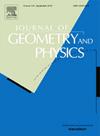广义标志流形在SU(N)上的非自然约简爱因斯坦度量
IF 1.2
3区 数学
Q1 MATHEMATICS
引用次数: 0
摘要
我们在紧李群SU(N)上得到了新的非自然约化的不变爱因斯坦度量。这是通过使用广义标志流形G/K=SU(k1+⋯+kp)/S(U(k1)×⋯×U(kp))和通过适当选择李子代数K的中心的正交基来实现的,这对SU(N)的Ad(K)不变度量提出了某些对称条件。我们还研究了爱因斯坦度量所发现的等距问题。本文章由计算机程序翻译,如有差异,请以英文原文为准。
Non naturally reductive Einstein metrics on SU(N) via generalized flag manifolds
We obtain new invariant Einstein metrics on the compact Lie group which are not naturally reductive. This is achieved by using the generalized flag manifold and by taking an appropriate choice of orthogonal basis of the center of the Lie subalgebra for K, which poses certain symmetry conditions to the -invariant metrics of . We also study the isometry problem for the Einstein metrics found.
求助全文
通过发布文献求助,成功后即可免费获取论文全文。
去求助
来源期刊

Journal of Geometry and Physics
物理-物理:数学物理
CiteScore
2.90
自引率
6.70%
发文量
205
审稿时长
64 days
期刊介绍:
The Journal of Geometry and Physics is an International Journal in Mathematical Physics. The Journal stimulates the interaction between geometry and physics by publishing primary research, feature and review articles which are of common interest to practitioners in both fields.
The Journal of Geometry and Physics now also accepts Letters, allowing for rapid dissemination of outstanding results in the field of geometry and physics. Letters should not exceed a maximum of five printed journal pages (or contain a maximum of 5000 words) and should contain novel, cutting edge results that are of broad interest to the mathematical physics community. Only Letters which are expected to make a significant addition to the literature in the field will be considered.
The Journal covers the following areas of research:
Methods of:
• Algebraic and Differential Topology
• Algebraic Geometry
• Real and Complex Differential Geometry
• Riemannian Manifolds
• Symplectic Geometry
• Global Analysis, Analysis on Manifolds
• Geometric Theory of Differential Equations
• Geometric Control Theory
• Lie Groups and Lie Algebras
• Supermanifolds and Supergroups
• Discrete Geometry
• Spinors and Twistors
Applications to:
• Strings and Superstrings
• Noncommutative Topology and Geometry
• Quantum Groups
• Geometric Methods in Statistics and Probability
• Geometry Approaches to Thermodynamics
• Classical and Quantum Dynamical Systems
• Classical and Quantum Integrable Systems
• Classical and Quantum Mechanics
• Classical and Quantum Field Theory
• General Relativity
• Quantum Information
• Quantum Gravity
 求助内容:
求助内容: 应助结果提醒方式:
应助结果提醒方式:


